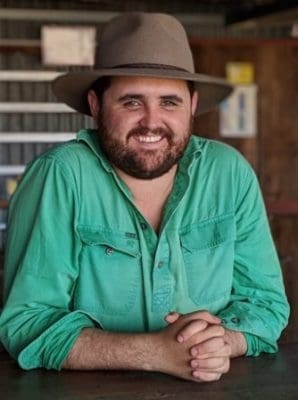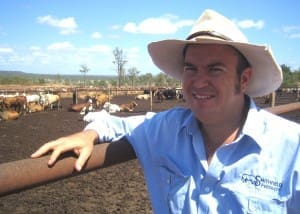THE Australian beef industry has a new price risk management tool at its disposal, following the launch today of StoneX Group’s Australian Northern Feeder Cattle Swaps product.
Every component of the Australian beef supply chain can potentially benefit from increased throughput stability while protecting margins against unfavourable price movements with the new platform.
StoneX vice president agriculture Nick Orssich said the new Swap was designed to help limit risk to cattle-dependent businesses, ranging from cattle producers to meat traders, that was previously very difficult to control.
“Droughts within the last five years forced cattle prices down as the market was flooded with livestock. Since the beginning of 2020, prices have more than doubled as rain totals normalised. With such swings in climate impact, market participants voiced a desire for an instrument to hedge their risks and manage their margins,” Mr Orssich said.
Providing the pricing foundation for the Swaps product is the Argus Northern Feeder Cattle Delivered Pricing Index, launched in October. It was developed in close consultation with StoneX and cattle industry participants in eastern Australia, including producers, lotfeeders and processors.
The Swap is cash-settled against the month average of the northern feeder steer index. StoneX acts as the counter-party to every trade, helping to eliminate counter-party risk and preserving anonymity for market participants.
Based on 0-2 tooth flatback feeder steers 380-480kg liveweight delivered Darling Downs, and priced in c/kg lwt, the index is published each Thursday at market close.
Mr Nick Orssich told Beef Central that the new platform was likely to take a little time to find its feet.
“Momentum will develop over time, not overnight,” he said.
“But feedback from industry has been very favourable, and we’re confident it will attract solid participation. We’re unlikely to see trades taking place the first few days, but we’re hopeful we will start to see bids and offers emerging reasonably quickly.”
Mr Orssich said the beef industry had been calling for greater transparency in the market for a long time.
“When Argus first started collecting data for the feeder steer index, the difference between the lows and highs that people were buying and selling feeders at was around 50c/kg (low 465c, high 515c.
“But by late last week, the difference between the low and the high was only 15c/kg. We can already see the effect that having the index in place is having – helping make it a lot more efficient in peoples’ day to day buying and selling.”
After today’s first day of operation, bids and offers for August September delivery, for example, were 505-530c/kg.

Tim Jude
Tim Jude, StoneX’s Sydney-based livestock and commodities broker, said the Argus Northern Feeder Cattle Delivered Pricing Index was the perfect complement to StoneX’s Australian Feeder Cattle Swap.
“This swap will be an important tool that will allow the entire cattle vertical in eastern Australia as well as internationally to hedge their price risk effectively,” Mr Jude said.
“For decades, cattle-dependent businesses in Australia have had to run their operations without the benefits of price transparency or the tools they need to manage their input and output costs actively.
“Lately, increases in price volatility, climate variability and dependence on international markets have only exacerbated these challenges in the form of greater price risk. The new Feeder Cattle Swap can help mitigate these risks by providing price transparency, the ability to benchmark, and a secure price risk transfer mechanism,” Mr Jude said.
Participation is key
Australian live cattle futures contracts have been launched twice in the past 35 years, but failed both times due mostly to a lack of liquidity and issues surrounding settlement of contracts, and the relevance, in the spread risk on 100-day cattle or feeders, for example.

Jason Shearer-Smith in the pens at Smithfield
Queensland lotfeeder Jason Shearer Smith, director of Smithfield Cattle Co, which operates large commercial yards at Proston and Goondiwindi, welcomed the arrival of the risk management hedging tool.
“Historically, when these sorts of products came out in the past, they had their problems – mostly through lack of support,” Mr Shearer Smith said.
“Stakeholders in the past said they wanted price risk management tools, but then didn’t tend to use them.”
“But this latest version, using Swaps, is very specific, and that’s to its advantage,” he said.
“Anything the industry can access to help manage risk has to be a good thing – particularly given how dear feeder cattle currently are. In many ways, it’s a good time to be launching a hedging tool like this,” Mr Shearer Smith said.
“And the industry is now a lot more sophisticated than it was in the past in terms of supply chains, driven by branded beef and program business with large, long-term customers. It means there could be a higher level of appetite for a hedging tool this time.”
Mr Shearer Smith said the trial weekly index figures that had been produced in recent months in the lead-up to the launch of the Swaps product were representative of the feeder market it was based on. The test could be whether this could be distorted in some way by somebody holding a big position.
“But anything that can help manage risk and improve supply is a benefit to all stakeholders along the chain. Above all, I’d simply encourage potential participants to have a crack. If stakeholders have a go with it, instead of sitting on the fencing and watching, the thing just does not get off the ground.”
“Everyone talks about wanting to have the ability to manage risk, but taking the next step and actually participating – even if only in a small way – is the answer in giving the product some traction, and guaranteeing it will last.
Understanding Swaps
So for those unfamiliar with risk management tools, what are Swaps?
Swaps are paper contracts where the risk is offset between two parties – with equal and opposite risks. In this example, StoneX stands in the middle, meaning the counter-party for both buyer and seller is StoneX. Neither side knows who the counter-party is. This eliminates any counter-party risk, and also maintains anonymity between the two parties – an important feature for the cattle and beef industry in Australia, where many players like to ‘hold their cards close to their chest.’
Margin facilities may also be provided by StoneX after the program’s launch, meaning participants would not have to tie-up working capital to trade.
Used in combination, the Argus Northern Feeder Cattle Delivered Pricing Index and the Australian Feeder Cattle Swap can help stakeholders manage risk, protect margins, monitor price spreads and track opportunities.
About StoneX*
StoneX (some readers may remember the company under its previous name INTL FCStone) is an international financial services network that specialises in hedging tools like forward contracts and swaps across a range of agricultural commodities. It connects companies, organisations, traders and investors to the global markets through a blend of digital platforms, end-to-end clearing and execution services. Click here to access StoneX’s website.

Could we have some examples on exactly how these tools work for cattle producers and feedlotters please?